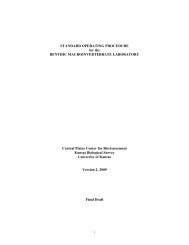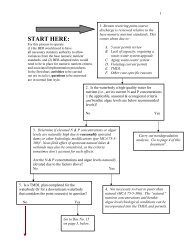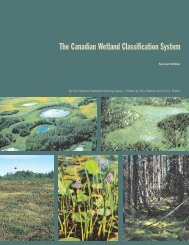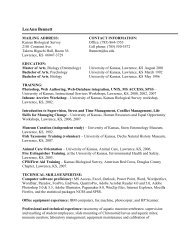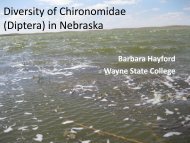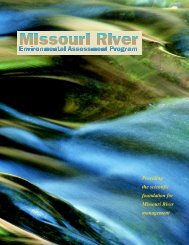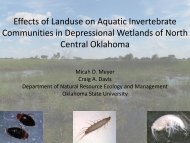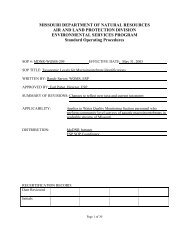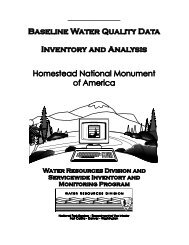Koontz, J., D.G. Huggins, C.C. Freeman, D.S. Baker - Central Plains ...
Koontz, J., D.G. Huggins, C.C. Freeman, D.S. Baker - Central Plains ...
Koontz, J., D.G. Huggins, C.C. Freeman, D.S. Baker - Central Plains ...
You also want an ePaper? Increase the reach of your titles
YUMPU automatically turns print PDFs into web optimized ePapers that Google loves.
Mean Conductivity mS/cm<br />
0.6<br />
0.5<br />
0.4<br />
0.3<br />
0.2<br />
0.1<br />
0.0<br />
40 47 72<br />
Ecoregion<br />
Figure 8. Error bar chart of ecoregional means of mean conductivity values: 40 - <strong>Central</strong><br />
Irregular <strong>Plains</strong>, 47 - Western Corn Belt <strong>Plains</strong>, and 72 - Interior River Valleys and Hills. Error<br />
bars are measures of standard error.<br />
Mean value for the mean conductivity measures in the <strong>Central</strong> Irregular <strong>Plains</strong> ecoregion was<br />
0.205 mS/cm, well below the values found in the Western Corn Belt Plain (0.342 mS/cm) and<br />
the Interior River Valleys and Hills (0.307 mS/cm). Median values for the ecoregions were<br />
similarly significantly different when Kruskal-Wallace non-parametric medians test was<br />
performed. Many significant relationships between the mean conductivity and other assessment<br />
metrics were observed and will be discussed later.<br />
Depth measures<br />
Mean and maximum depth measures for the Phase II samples (n = 38) were not normally<br />
distributed thus log transformation of the depth values was necessary to perform the ANOVA‟s<br />
to examine regional and class differences (Figure 9). Significant differences in mean and<br />
maximum depths were not observed among ecoregions. When major hydrological system<br />
classes were analyzed, log means and variance for the lacustrine sample population (n = 15) were<br />
significantly higher in mean and maximum depths than the palustrine sites (n = 18) for both<br />
measures and higher in mean depth than the riverine sample population (n = 5). Secchi depths<br />
were also observed as being statistically higher in means among the lacustrine than both<br />
palustrine and riverine samples.<br />
21 of 84



